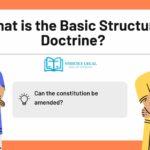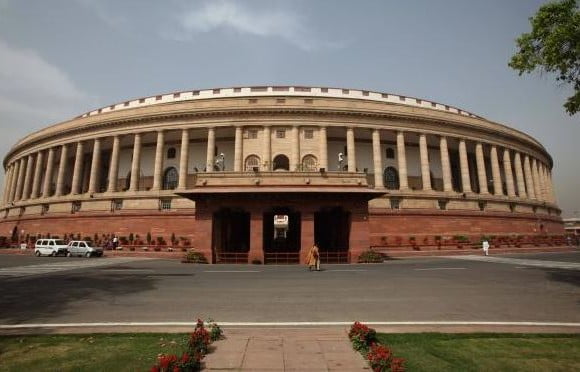In this article, we will discuss the meaning and procedure of the Constitutional Amendments with reference to the Indian Constitution.
Table of Contents
Meaning of Amendment
Generally speaking, Amendment refers to change or ratify something that is already established usually with a motive to improve. In other words, “A minor change or addition designed to improve a text, piece of legislation, etc.”
We could also use popular synonyms like MODIFICATION, REVISION, ALTERATION and sorts.
Why do we need to amend the constitution?
Before we start discussing if Amendments to the constitution are even possible we will first have to understand the reason it is even needed.
The framers of the Indian Constitution had a clear vision of the type of country that they wanted India to be. Keeping that in mind they drafted the framework of laws of the nation, the supreme laws.
Laws are something that are dynamic in their very nature and the framers of the constitution had imagined this before hand that with time the Indian society will grow and it would be impossible to hold it with a rigid constitution.
Late Prime Minister Pt. Nehru, “While we want this Constitution be as solid and permanent as we can make it, there is no permanence in the Constitution. There should be a certain flexibility. If you make anything rigid and permanent you stop the nation’s growth, of a living, vital, organic people………… In any event, we could not make this Constitution so rigid that it cannot be adopted to changing conditions. When the world is in a period of transition what we may do today may not be wholly applicable tomorrow”.
Who can Amend the Constitution?
Only the parliament vide its powers given under the Constitution of India itself can amend the constitution. However, due procudure has been established and should be followed.
How many Constitutional Amendments in India, yet?
As of January 2020, there have been 104 amendments of the Constitution of India since it was first enacted in 1950.
Types of Constitutional Amendments
Article 368 of the Indian Constitution mentions two types of amendments to the Indian Constitution.
- Amendments by a special majority of the Parliament (Lok Sabha & Rajya Sabha) and
- Secondly, Amendments by a special majority of the Parliament with the ratification by half of the states by a simple majority.
But, some other articles provide for the amendment of certain provisions of the Constitution by a simple majority of Parliament i.e. a majority of the members of each of the house present and voting (similar to an ordinary legislative process).
Notably, these amendments are not deemed to be amendments of the Constitution for the purpose of Article 368. Therefore, the Constitution can be amended in three ways:
- Amendments by a simple majority of the parliament: The amendments considered in Article 5, 169, and Article 239-A can be made by a simple majority. These Articles are specifically excluded from the purview of the procedure prescribed in Article 368.
- Amendments by a special majority of the Parliament: Articles of the Constitution which can be amended by the special majority as laid down in Article 368. All constitutional amendments, other than those referred to above, come within this category and must be effected by a majority of the total membership of each House of Parliament as well as by a majority of not less than 2/3 of the members of that House present and voting.
- Amendments by a special majority of the parliament and the ratification of the state legislature: The article which requires, in addition to the special majority mentioned above, ratification by not less than 1/2 of the State Legislatures. The States are given an important voice in the amendment of these matters.
These are fundamental matters where states have important power under the Constitution and any unilateral amendment by Parliament may vitally affect the fundamental basis of the sort of federal system built up by the Constitution.
This class of Articles consists of amendments that seek to make any change in the provisions mentioned in Article 368.
More about Constitutional Amendments by a special majority and the ratification by the state legislature:
The following articles require such special majority and ratification by the States :
- Articles 54 and 55: Election of the President
- Articles 73 and 162, Article 241 or 279-A: Extent of the Executive powers of the Union and States
- Articles 124 to 147, 214 to 231, 241: Articles dealing with judiciary, Supreme Court, High Court in the States and Union territories
- Articles 245 to 255: Distribution of Legislative powers between the Center and the State
- Article 279A- Goods and Service Tax Council
- Any of the Lists of the 7th Schedule
- 4th Schedule: Representation of States in Parliament.
- Article 368 itself.
The procedure of Constitutional Amendments
Dr Ambedkar while summing up the provisions contained in Article 368 observed as under:
“The Assembly has not only refrained from putting a seal of finality and infallibility upon this Constitution by denying the people the right to amend the Constitution as in Canada or by making the amendment of the Constitution subject to the fulfilment of extraordinary terms and conditions as in America or Australia, but has provided for a facile procedure for amending the Constitution…. If those who are dissatisfied with the Constitution have only to obtain a two-thirds majority and, if they cannot obtain even a two-thirds majority in the Parliament elected on adult franchise in their favour, their dissatisfaction with the Constitution cannot be deemed to be shared by the general public.”
Article 368 of our Indian Constitution deals with the powers of parliament to amend the constitution and its procedure and those procedures are as follows:
- Constitutional Amendments can only be initiated by introducing a bill for any purpose from either house of the parliament and not in any of the state legislatures.
- The bill can be introduced either by a minister or by a private member and does not require prior permission of the president or the speaker.
- The bill must be passed with the due procedure like where the amendments are to be made to the provisions that require special majority then special majority must be attained or if it requires special majority and state legislature’s ratification as discussed earlier then it must be attained.
- After duly passed by both the Houses of Parliament and ratified by the State legislatures of half of the state legislature, where necessary, the bill is presented to the president assent.
- However, the President must give his assent to the bill. He can neither withhold his assent to the bill nor return the bill for the reconsideration of the Parliament.
- After the president’s assent, the bill becomes an Act (i.e., a constitutional amendment act) and the constitution stands amended in accordance with the terms of the Act.
So, the parliament is the only mode for the Constitutional Amendments?
Yes, that is one way of saying it. India is a democratic country and the parliament or the legislatures of each of the states are the voices of people. The parliament has the sole power to amend the constitution.
However, this power is leased. There is a fairy tale between the parliament and the judiciary discussing as to who’s supreme, but thats for another blog.
In short, the judiciary has been able to establish a rule known as the Basic Structure Doctrine stating that the parliament cannot make any changes whatsoever that destroy the basic framework or tampers with the very nature of the constitution.
The Basic Structure Doctrine states there are certain fundamental structures and founding principles of the constitution which make the backbone of the constitution. In simple terms, they are ideologies of the constitution which are essential for the survival of the constitution. Some examples are Free and Fair Election, the Federal nature of the Nation, Judicial review and Separation of Power. The government is restricted from touching these contours of the constitution through amendments.
Thus, while the Parliament has powers to amend various sections of the constitution, they cannot touch, amend, repeal or add sections into the constitution which would affect its basic structure in the process. [Keshavananda Bharati v.State of Kerala]
Important Amendments
| Amendment Act No. | Articles Amended | Brief Overview |
|---|---|---|
| 7th Amendment Act 1956 | Article 1 Article 3 Article 49 Article 80 Article 81 Article 82 Article 131 Article 153 Article 158 Article 168 Article 170 Article 171 Article 216 Article 217 Article 220 Article 222 Article 224 Article 230 Article 231 Article 232 Part VIII First, Second, Fourth and Seventh Schedules of Indian Constitution | Reorganisation of states on linguistic basis Abolition of Class A, B, C and D states Introduction of Union Territories |
| 9th Amendment Act, 1960 | Schedule 1 of Indian Constitution | Adjustments to Indian Territory as a result of an agreement with Pakistan |
| 10th Amendment Act, 1961 | Article 240 First Schedule | Dadra, Nagar, and Haveli incorporated in the Union of Indian as a Union Territory |
| 12th Amendment Act 1961 | Article 240 First Schedule | Goa, Daman and Diu incorporated in the Indian Union as a Union Territory |
| 13th Amendment Act, 1963 | Article 170 Added new article 371A | Nagaland was formed with special status under Article 371A |
| 14th Amendment Act, 1962 | Articles 81 and 240 First and fourth Schedules Added Article 239A | Pondicherry incorporated into the Indian Union |
| 21st Amendment Act, 1967 | Eighth Schedule | Sindhi language was language into 8th Schedule of Indian Constitution |
| 26th Amendment Act 1971 | Article 366 Added Article 363A Removed Articles 291 and 362 | Privy Purse was abolished. |
| 36th Amendment Act 40th Amendment Act 1975 | Articles 80 and 81 First and fourth Schedules Added Article 371F Removed Article 2A | Sikkim incorporated as an Indian state |
| 42nd Amendment Act 1976 | Article 31 Article 31C Article 39 Article 55 Article 74 Article 77 Article 81 Article 82 Article 83 Article 100 Article 102 Article 103 Article 105 Article 118 Article 145 Article 150 Article 166 Article 170 Article 172 Article 189 Article 191 Article 192 Article 194 Article 208 Article 217 Article 225 Article 226 Article 227 Article 228 Article 311 Article 312 Article 330 Article 352 Article 353 Article 356 Article 357 Article 358 Article 359 Article 366 Article 368 Article 371F Seventh Schedule Added Articles 31D, 32A, 39A, 43A, 48A, 131A, 139A, 144A, 226A, 228A and 257A Added Parts IVA and XIVA | Fundamental Duties prescribed, India became Socialist Secular Republic |
| 44th Amendment Act 1978 | Article19 Article 22 Article 30 Article 31A Article 31C Article 38 Article 71 Article 74 Article 77 Article 83 Article 103 Article 105 Article 123 Article 132 Article 133 Article 134 Article 139A Article 150 Article 166 Article 172 Article 192 Article 194 Article 213 Article 217 Article 225 Article 226 Article 227 Article 239B Article 329 Article 352 Article 356 Article 358 Article 359 Article 360 Article 371F Ninth Schedule Added Articles 134A and 361A Deletion of Articles 31, 257A and 329A | Right to Property removed from the list of fundamental rights |
| 61st Amendment Act 1989 | Article 326 | Voting age decreased from 21 to 18. |
| 71st Amendment Act 1992 | Article 332 | Manipuri, Konkani, and Nepali were added in the 8th Schedule of Indian Constitution |
| 73rd Amendment Act 1992 | Added Part IX | Introduction of Panchayat Raj Addition of Part IX to the Indian Constitution |
| 74th Amendment Act 1992 | Article 280 Article 280 Added Part IXA | Introduction of Municipalities and Nagarpalikas |
| 86th Amendment Act 2002 | Amended Articles 45 and 51A Added Article 21A | Free and compulsory education to children between 6 and 14 years |
| 87th Amendment Act 2003 | Eighth Schedule | Santhali, Bodo, Dogri, and Maithili in the 8th Schedule of Indian Constitution Service Tax introduced. |
| 95th Amendment Act 2010 | Article 334 | Extension of reservation of seats for SC/ST Nomination of Anglo-Indian members in Parliament and State Assemblies |
| 96th Amendment Act 2011 | Eighth Schedule | Replaced Odia for Oriya in the 8th Schedule to the Indian Constitution |
| 97th Amendment Act 2012 | Articles 19 Added Part IXB | Introduction of Part IXB in the Constitution of India relating to Co-operative Societies |
| 100th Amendment Act 2015 | Amendment of First Schedule | Exchange of some enclave territories with Bangladesh Conferment of citizenship rights to citizens of enclave’s resulting to signing of Land Boundary Agreement (LBA) Treaty between India and Bangladesh. |
| 101st Amendment Act 2016 | Article 248 Article 249 Article 250 Article 268 Article 269 Article 270 Article 271 Article 286 Article 366 Article 368 Amended Sixth Schedule and Seventh Schedule Deletion of Article 268A | Introduction of Goods and Services Tax (GST) |
| 102nd Amendment Act 2018 | Addition of articles 338B, 342A, and Added Clause 26C Omitted Article 340 Modification of articles 338, 366 | Constitutional Status to National Commission for Backward Classes |
| 103rd Amendment Act 2019 | Amendment to Article 15, added Clause 6 Amendment to Article 16, added Clause 6 | A maximum of 10% Reservation for Economically Weaker Sections of citizens of classes other than the classes mentioned in clauses (4) and (5) of Article 15, i.e. Classes other than socially and educationally backward classes of citizens or the Scheduled Castes and the Scheduled Tribes. |
| 104th Amendment Act 2020 | Amended Article 334 | The abolishment of Legislative councils in mentioned States. Dual Citizenship for Indian origin outside the country. Quota to educationally backward classes Quota for religious minorities in government service. |
Conclusion
Through this article, we have explored the topic of Constitutional Amendment. We have found that there is something called the Basic Structure of the Constitution and it is against the basic principles of justice to breach it.
The government in many landmark cases tried to amend the constitution in order to make it easier to ensure the best for the public interest.
The judiciary was absolutely against the whole idea, in later judgments we have seen the judges opening up to the idea of the executive being able to override certain aspects of the basic structure in order to ensure the best for the public interest.
But again, later on, judgments, unless the judiciary was absolutely convinced that such Acts would be beneficial in ensuring greater public welfare, they were strict about amendments that violated the basic structure.
What we must realize is that the constitution is the backbone of this democracy. While it was revolutionary of the fathers of our constitution to provide provisions to amend the constitution, it is essential that such provisions are not misused. Misuse could result in excessive power of the legislative or the executive which could tear the fabric of our democracy.
We shall discuss the important Judgements relating to Constitutional Amendments on another blog very soon.

Trying to learn the art of advocacy.
Practicing at the Calcutta High Court and in its vicinity.





